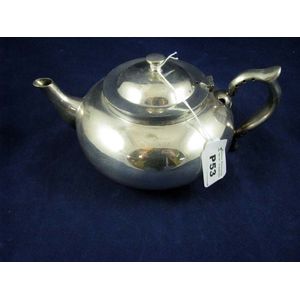Paul Storr Silver Teapot with Acorn Finial and Scrolls
You must be a subscriber, and be logged in to view price and dealer details.
Subscribe Now to view actual auction price for this item
When you subscribe, you have the option of setting the currency in which to display prices to $Au, $US, $NZ or Stg.
- Finial - An architectural decoration, found on the upper parts of of an object. On furniture they are usually found on pediments, canopies and shelf supports. On smaller ceramic or silver items, such as spoons, they may decorate the top of the item itself, or the lid or cover where they provide a useful handle for removal.
Finials have a variety of shapes and forms. They may be urn-shaped, baluster shaped round or spiral, but usually taper into an upper point. Many real life shapes may also be used as finials, such as pineapples, berries, pinecones, buds, lotus and acorns. Sometimes animals such as a lion are depicted, or fish and dolphins. - William Iv - William IV was King of the United Kingdom and King of Hanover from 26 June 1830 until his death in 1837, and in English furniture design it represented the brief period between the end of the Regency period, and the beginning of the Victorian period.
- Acanthus - A stylized leaf motif, one of the primary decorative elements of classical Greek and Roman architecture, derived from the genus of flowering plants in the family Acanthaceae, native to tropical and subtropical regions of the Mediterranean area. It is a common element in classical Greek and Roman design, and is often seen in Corinthian and Composite order columns and used as a decorative element in English, European and Australian furniture, particularly on the curve of a leg, and as decoration for a corbel.
- Sterling Silver - Sterling silver is a mixture of 92.5% pure silver and 7.5% of another metal, usually copper. Fine silver is 99.9% pure silver, and is relatively soft and the addition of the very small amount of copper gives the metal enough strength and hardness to be worked into jewellery, decorative and household objects.
This item has been included into following indexes:
Visually similar items

An Edwardian sterling silver, four piece tea set. Assay marks London, 1904 and 1910, comprising of teapot, cream jug, sugar bowl and tea caddy. Teapot height 15 cm. Total weight 1360grams

Silver teapot Victorian 1854, makers JS & AS, inscription, 'Presented to Captain George Hyde by the Passengers of S.S.S. Argo on their way to Australia', approx 23oz troy

Silver plated Robur 'Pefect' tea pot

A Victorian silver mustard pot, the squat circular body raised on four compressed feet, gadroon top border, shell thumbpiece to the hinged lid with urn finial, no liner. Birmingham 1894 by George Nathan & Ridley Hayes. Weight 14.6 cm
